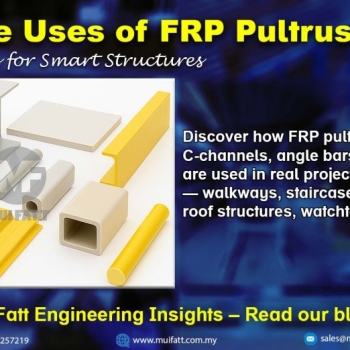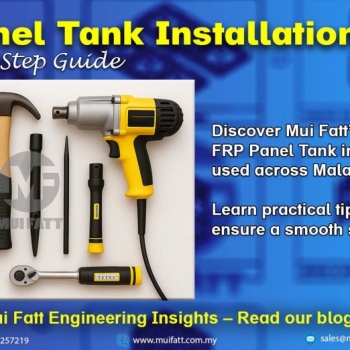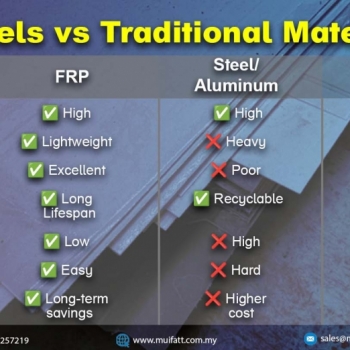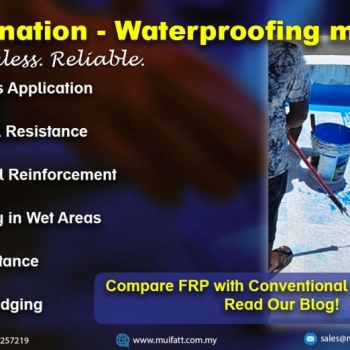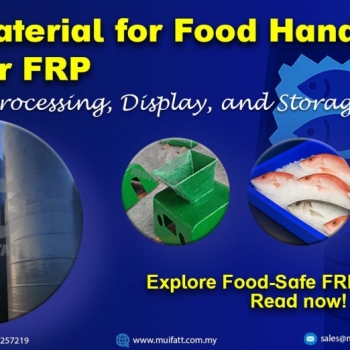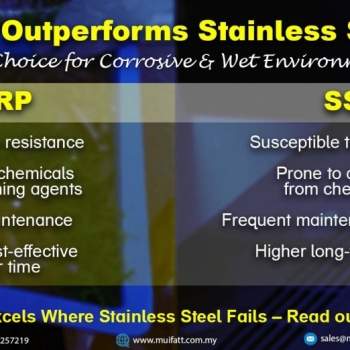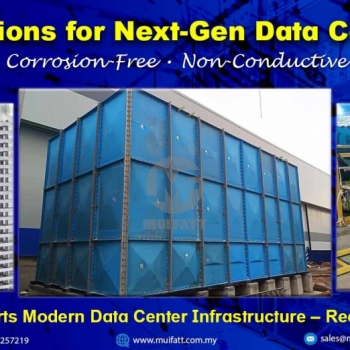FRP pultruded profiles are reshaping structural possibilities across Malaysia. From STP staircases to public park shelters, explore how these modular components enable custom FRP solutions—only from Mui Fatt.
The Ultimate Guide to Locking Mechanisms for FRP Molded Grating
26 Feb 2025
- Key Takeaways
- Why Locking Mechanisms Matter for FRP Molded Grating
- Types of Locking Clips for FRP Molded Grating
- Special Considerations for Minimesh Grating
- Installation Recommendations for Secure Locking
- Choosing the Right Locking Mechanism for Your Project
- Frequently Asked Questions (FAQs)
Key Takeaways
-
M clips are the recommended locking mechanism for standard FRP molded grating.
-
J clips and C clips offer alternative securing options based on application needs.
-
Minimesh grating requires disk plates for secure fastening.
-
Proper bolt length calculation is essential for stability.
-
Choosing the right clip type enhances safety and performance of FRP grating.
Why Locking Mechanisms Matter for FRP Molded Grating
Locking mechanisms play a critical role in ensuring the stability and safety of FRP molded grating. Without proper fastening, gratings may shift or become loose, leading to potential hazards in industrial and commercial applications. Selecting the appropriate locking clip is essential for optimal load distribution and longevity.
Types of Locking Clips for FRP Molded Grating
Different environments and structural requirements call for various locking methods. Below are the most commonly used locking clips for FRP molded grating:
M Clips (Recommended Option)
M clips are made of stainless steel and designed to hold the grating securely to the support structure.
Installation Guidelines:
-
Recommended 8 sets per standard panel.
-
Placement depends on the grating's support span and thickness.
-
Ensures maximum grip and prevents movement under heavy loads.
J Clips
J clips provide an alternative securing method by hooking onto the grating bars, preventing lateral movement.
Best Used For:
-
Light to medium-duty applications.
-
Situations where M clips may not be suitable due to space constraints.
C Clips
C clips function by clamping the grating to the supporting structure, offering additional security.
Best Used For:
-
High-vibration environments.
-
Areas requiring extra hold-down force.
Special Considerations for Minimesh Grating
Minimesh FRP grating has smaller openings, which necessitate a different locking mechanism. Disk plates are recommended for minimesh gratings due to their firm grip and ability to lock through the grating securely.
Disk Plate Installation Tips:
-
Made of stainless steel for corrosion resistance.
-
Uses bolts and nuts to secure the grating.
-
Bolt length should be twice the grating thickness (e.g., 25mm thick grating requires at least 50mm bolts; 38mm requires 75mm bolts).
-
Site conditions may require adjustments to these recommendations.
Installation Recommendations for Secure Locking
A well-secured FRP grating system ensures long-term durability and safety. Consider these best practices:
-
Always follow manufacturer recommendations for clip positioning.
-
Ensure proper bolt length selection based on grating thickness and support structure.
-
Inspect the grating system periodically to prevent loosening over time.
Choosing the Right Locking Mechanism for Your Project
Selecting the right locking clip depends on factors such as application, environment, and load requirements. Consulting with a professional manufacturer ensures that you get the most suitable locking mechanism for your FRP molded grating system.
Enhance Your Project with Our High-Quality FRP Molded Grating
For durable, high-performance FRP grating with secure locking mechanisms, explore our range of Mui Fatt FRP Molded Gratings today!
Frequently Asked Questions (FAQs)
How many M clips should I use for standard FRP molded grating?
We recommend using 8 sets per standard panel, but placement depends on the support span and grating thickness.
Can I use J clips instead of M clips?
Yes, J clips can be used for light-duty applications where space constraints prevent M clip installation.
Why do minimesh gratings require disk plates?
Minimesh grating has smaller openings, making it difficult to secure with traditional clips. Disk plates provide a more secure fastening option.
How do I determine the correct bolt length for my grating?
The bolt length should be twice the grating thickness (e.g., for a 25mm thick grating, use at least a 50mm bolt).
#FRPgratinglockingmethod #Mclip #Jclip #Cclip #diskplate #minimeshgrating #FRPgratinginstallation #gratingsecurity #gratinginstallation
Disclaimer:-
The content on this site is for general information and entertainment purposes and does not constitute legal counsel. We strive to keep our information as accurate as possible. However, we make no warranties about the completeness, accuracy, reliability, suitability, or availability with respect to the information contained on this page. You should rely on this information at your own risk. This website may include links to other third-party sites. These links are provided as a convenience to you as a reader, user, or browser only. We make no representation, warranty, or guarantee, nor do we endorse or take responsibility for any of the content of such sites.
Stay in touch with us if you’re interested in hearing from us promptly.
- Website - https://www.muifatt.com.my/home/
- Facebook - https://www.facebook.com/muifattmarketing
- Instagram - https://www.instagram.com/muifattmarketing/
- Google - https://goo.gl/maps/WxVY13gNcaRTS7Jp6
- Youtube - http://www.youtube.com/@MuiFattMarketing
- TikTok - https://www.tiktok.com/@muifattmarketing
- LinkedIn - https://www.linkedin.com/company/mui-fatt-marketing-sdn-bhd-
- Linktree - https://linktr.ee/muifattmarketing
- Shopee - https://www.shopee.com.my/muifattmarketing
- Lazada - https://www.lazada.com.my/shop/mui-fatt-marketing
Recent Blog
Mui Fatt Engineering Insights - FRP Panel Tank Installation
Get to know the step-by-step assembly process of FRP sectional panel tanks, based on Mui Fatt’s industry-proven practices. This easy-to-digest guide is ideal for project managers, contractors, and technical personnel involved in water storage tank installation across Malaysia.
FRP Panels vs Traditional Alternatives: The Ultimate Guide to Durability and Sustainability
Explore why FRP (Fiberglass-Reinforced Plastic) panels outperform traditional materials like steel, plywood, and PVC in durability, sustainability, and cost-effectiveness. Discover real-world applications in MyKiosk projects and cold truck panel assembly, where FRP’s superior insulation, corrosion resistance, and lightweight properties deliver long-term benefits.
Comparing FRP Waterproofing with Traditional Systems
Is FRP lamination a better waterproofing method than traditional systems? Explore this complete guide with real project examples and see why FRP is gaining traction across Malaysia.
Benefits of FRP in Food Handling & Processing
With hygiene, durability, and corrosion resistance at its core, FRP (Fibreglass Reinforced Plastic) is becoming a preferred material in the food industry. This article explores why FRP is ideal for food handling equipment such as supermarket fish trays, water tanks, and food factory platforms, plus how Mui Fatt is delivering proven solutions through its successful FRP applications.
Mui Fatt Insights: Advanced Materials for Modern Needs
Is stainless steel the best for wet areas? This article explains why more industries are switching to FRP for its corrosion resistance, hygiene benefits, and longevity, especially in food displays and chemical exposure zones.
How FRP Supports Modern Data Center Infrastructure
Discover how fiberglass-reinforced plastic (FRP) is reshaping data center construction. Learn its key advantages, comparisons with other materials, and where to apply FRP—from rooftop chillers to cooling tanks.
Understanding FRP Filament Winding: Process, Benefits & Comparison
This article explores the FRP filament winding manufacturing method, how it differs from other FRP techniques, why it’s still widely used, and its long-term value for projects like high-strength tanks and cylinders.
